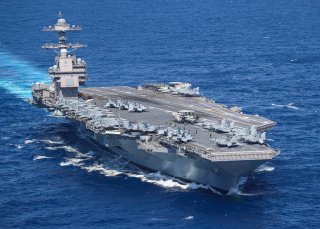How SPY-6 Radars Give the U.S. Navy Next-Level Connectivity
The SPY-6 family is a collection of commonly architected technologies designed to improve surface ships’ radar range, sensitivity, and targeting capability.
The U.S. Navy’s fleet-wide radar strategy is a multi-pronged attempt to counter a new generation of enemy weapons, such as lasers and hypersonic missiles, lower developmental costs, and ensure technical commonality across the force in support of continued modernization.
These Raytheon-made radars make up the SPY-6 family of systems. The SPY-6 family is a collection of commonly architected technologies designed to improve surface ships’ radar range, sensitivity, and targeting capability.
The decision for the new radar emerged from a special radar commonality and affordability study conducted by the Navy several years ago, which looked at finding technologies that would work across multiple platforms.
The current Navy strategy seeks to cultivate advanced technology while establishing greater technical commonality, facilitating modernization, and upgrading radar systems across the fleet. Such an approach also intends to improve sustainment, permit hardware to integrate new software as threats emerge, and lower acquisition costs throughout the system's life cycle.
For example, the Navy and Raytheon's Enterprise Air Surveillance Radar (EASR) is being engineered as a three-faced phased array radar, with a focus on making it adaptive. For cost and cross-fleet commonality reasons, EASR was chosen as the future radars for carriers and amphibious vehicles, even though the first Ford-Class carrier uses Dual-Band Radar. Dual-Band Radars were initially slated to go on twenty-seven new, high-tech DDG 1000 destroyers. However, when the Navy changed plans and only decided to procure three DDG 1000s, the price of Dual-Band Radar went up.
Navy developers say commonality and cost reduction are entirely consistent with integrating next-generation detection ability. Furthermore, carriers do not need radar as sensitive and powerful as Dual-Band Radar, partly because carriers typically have a destroyer or a cruiser nearby to help protect them by providing a defensive radar envelope.
EASR will not have some of the technical capabilities of the Dual-Band Radar, such as fire control radar capability; however, engineering the new EASR for the USS Kennedy, or CVN 79, will save the Navy $180 million in the cost of the ship. This cost-saving is quite significant for Navy developers, who have been implementing lessons learned from the construction of the USS Ford during the building of the new USS Kennedy.
EASR will, among other things, be configured to perform the functions of existing ship radars, such as the AN/SPS-49 and the three-dimensional AN/SPS-48 anti-aircraft sensor currently on Navy destroyers and cruisers. However, the new EASR radar will be upgradeable, scalable, and able to integrate several missions into a single system.
The Office of Naval Research previously helped develop the radar through a $6 million EASR study and development contract with Raytheon. EASR radar could also be back fitted onto Nimitz-class carriers, which will be around through 2057.
Kris Osborn is the Defense Editor for the National Interest. Osborn previously served at the Pentagon as a Highly Qualified Expert with the Office of the Assistant Secretary of the Army—Acquisition, Logistics & Technology. Osborn has also worked as an anchor and on-air military specialist at national TV networks. He has appeared as a guest military expert on Fox News, MSNBC, The Military Channel, and The History Channel. He also has a Master's Degree in Comparative Literature from Columbia University.
Image: DVIDS.

